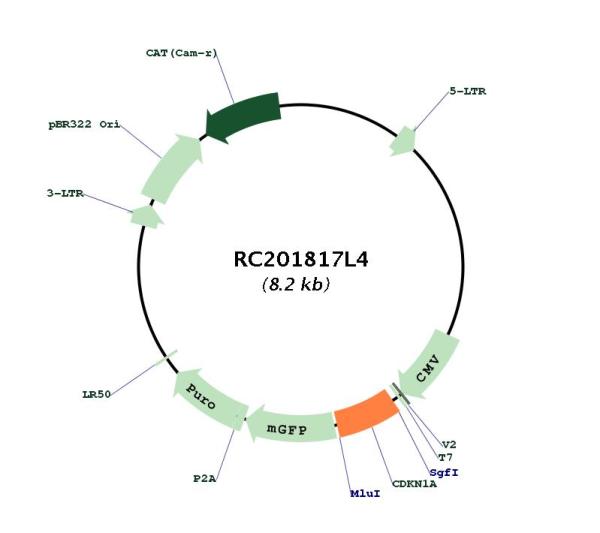p21 (CDKN1A) (NM_000389) Human Tagged Lenti ORF Clone
CAT#: RC201817L4
- LentiORF®
Lenti ORF clone of Human cyclin-dependent kinase inhibitor 1A (p21, Cip1) (CDKN1A), transcript variant 1, mGFP tagged
"NM_000389" in other vectors (6)
USD 365.00
Specifications
| Product Data | |
| Type | Human Tagged ORF Clone |
| Tag | mGFP |
| Symbol | p21 |
| Synonyms | CAP20; CDKN1; CIP1; MDA-6; P21; p21CIP1; SDI1; WAF1 |
| Vector | pLenti-C-mGFP-P2A-Puro |
| E. coli Selection | Chloramphenicol (34 ug/mL) |
| Mammalian Cell Selection | Puromycin |
| Sequence Data |
The ORF insert of this clone is exactly the same as(RC201817).
|
| Restriction Sites |
SgfI-MluI
Cloning Scheme for this gene
Plasmid Map

|
| ACCN | NM_000389 |
| ORF Size | 492 bp |
| OTI Disclaimer | Due to the inherent nature of this plasmid, standard methods to replicate additional amounts of DNA in E. coli are highly likely to result in mutations and/or rearrangements. Therefore, OriGene does not guarantee the capability to replicate this plasmid DNA. Additional amounts of DNA can be purchased from OriGene with batch-specific, full-sequence verification at a reduced cost. Please contact our customer care team at custsupport@origene.com or by calling 301.340.3188 option 3 for pricing and delivery. The molecular sequence of this clone aligns with the gene accession number as a point of reference only. However, individual transcript sequences of the same gene can differ through naturally occurring variations (e.g. polymorphisms), each with its own valid existence. This clone is substantially in agreement with the reference, but a complete review of all prevailing variants is recommended prior to use. More info |
| OTI Annotation | This clone was engineered to express the complete ORF with an expression tag. Expression varies depending on the nature of the gene. |
| Product Components | The ORF clone is ion-exchange column purified and shipped in a 2D barcoded Matrix tube containing 10ug of transfection-ready, dried plasmid DNA (reconstitute with 100 ul of water). |
| Reconstitution | 1. Centrifuge at 5,000xg for 5min. 2. Carefully open the tube and add 100ul of sterile water to dissolve the DNA. 3. Close the tube and incubate for 10 minutes at room temperature. 4. Briefly vortex the tube and then do a quick spin (less than 5000xg) to concentrate the liquid at the bottom. 5. Store the suspended plasmid at -20°C. The DNA is stable for at least one year from date of shipping when stored at -20°C. |
| Reference Data | |
| RefSeq | NM_000389.2 |
| RefSeq Size | 2175 bp |
| RefSeq ORF | 495 bp |
| Locus ID | 1026 |
| UniProt ID | P38936 |
| Cytogenetics | 6p21.2 |
| Domains | CDI |
| Protein Families | Druggable Genome |
| Protein Pathways | Bladder cancer, Cell cycle, Chronic myeloid leukemia, ErbB signaling pathway, Glioma, Melanoma, p53 signaling pathway, Pathways in cancer, Prostate cancer |
| MW | 18.2 kDa |
| Gene Summary | This gene encodes a potent cyclin-dependent kinase inhibitor. The encoded protein binds to and inhibits the activity of cyclin-cyclin-dependent kinase2 or -cyclin-dependent kinase4 complexes, and thus functions as a regulator of cell cycle progression at G1. The expression of this gene is tightly controlled by the tumor suppressor protein p53, through which this protein mediates the p53-dependent cell cycle G1 phase arrest in response to a variety of stress stimuli. This protein can interact with proliferating cell nuclear antigen, a DNA polymerase accessory factor, and plays a regulatory role in S phase DNA replication and DNA damage repair. This protein was reported to be specifically cleaved by CASP3-like caspases, which thus leads to a dramatic activation of cyclin-dependent kinase2, and may be instrumental in the execution of apoptosis following caspase activation. Mice that lack this gene have the ability to regenerate damaged or missing tissue. Multiple alternatively spliced variants have been found for this gene. [provided by RefSeq, Sep 2015] |
Documents
| Product Manuals |
| FAQs |
| SDS |
Resources
Other Versions
| SKU | Description | Size | Price |
|---|---|---|---|
| RC201817 | CDKN1A (Myc-DDK-tagged)-Human cyclin-dependent kinase inhibitor 1A (p21, Cip1) (CDKN1A), transcript variant 1 |
USD 225.00 |
|
| RC201817L1 | Lenti ORF clone of Human cyclin-dependent kinase inhibitor 1A (p21, Cip1) (CDKN1A), transcript variant 1, Myc-DDK-tagged |
USD 525.00 |
|
| RC201817L2 | Lenti ORF clone of Human cyclin-dependent kinase inhibitor 1A (p21, Cip1) (CDKN1A), transcript variant 1, mGFP tagged |
USD 525.00 |
|
| RC201817L3 | Lenti ORF clone of Human cyclin-dependent kinase inhibitor 1A (p21, Cip1) (CDKN1A), transcript variant 1, Myc-DDK-tagged |
USD 525.00 |
|
| RG201817 | CDKN1A (tGFP-tagged) - Human cyclin-dependent kinase inhibitor 1A (p21, Cip1) (CDKN1A), transcript variant 1 |
USD 425.00 |
|
| SC119947 | CDKN1A (untagged)-Human cyclin-dependent kinase inhibitor 1A (p21, Cip1) (CDKN1A), transcript variant 1 |
USD 225.00 |
{0} Product Review(s)
Be the first one to submit a review






























































































































































































































































 Germany
Germany
 Japan
Japan
 United Kingdom
United Kingdom
 China
China


